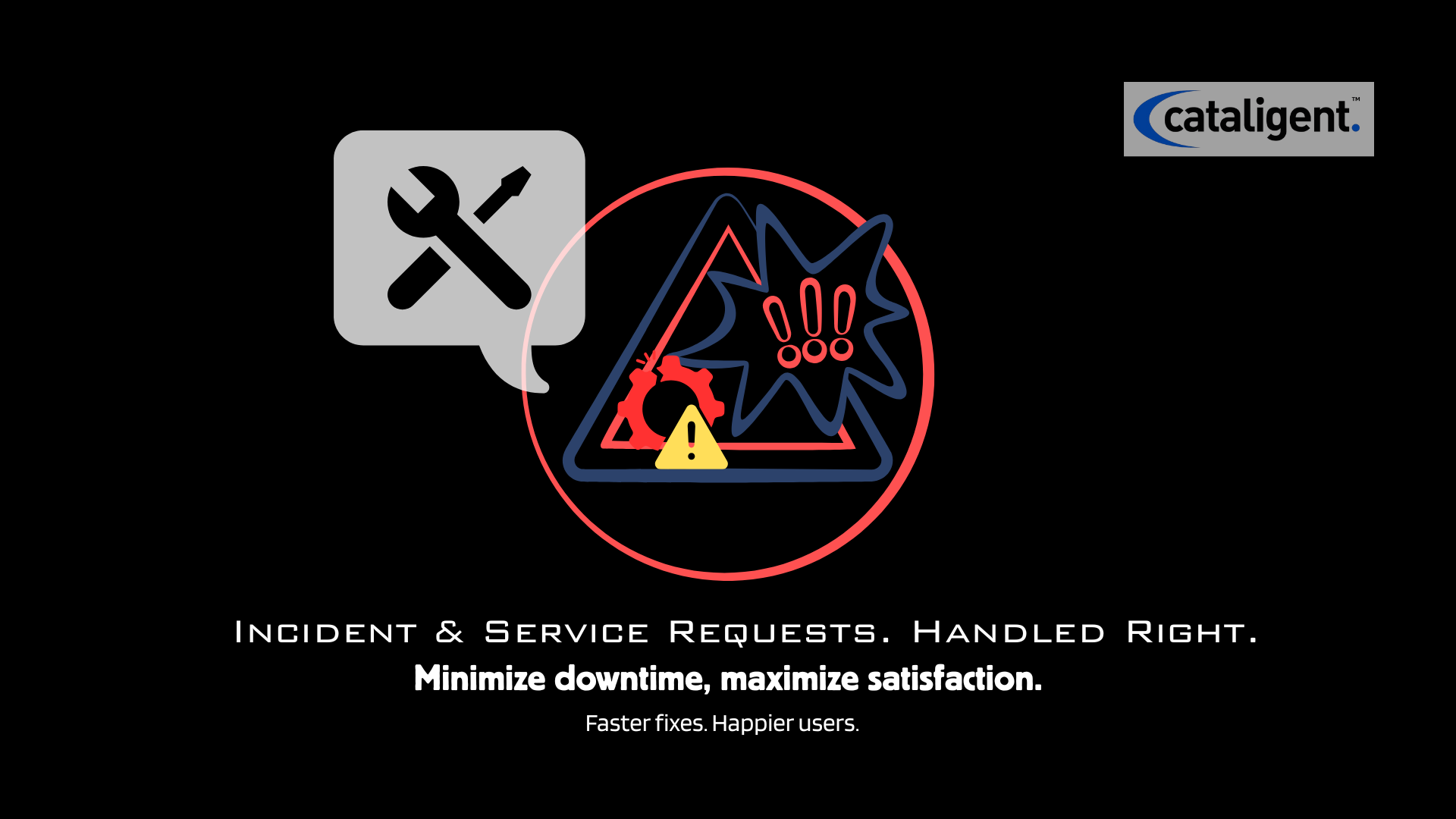What is Incident & Service Request Management?
Incident and service request management is a foundational component of IT Service Management (ITSM) that focuses on efficiently handling IT issues, service requests, and user queries. Incidents are unplanned interruptions or reductions in the quality of IT services, while service requests are formal user demands for information, access, or standard IT services. Effective management ensures that incidents are resolved quickly, service requests are fulfilled accurately, and business operations continue without disruption.
Cataligent supports organizations in implementing comprehensive ITSM frameworks that streamline the process of incident logging, categorization, prioritization, and resolution, with clear accountability for each task.
Why Incident & Service Request Management is Critical
Efficient management of incidents and service requests is vital for maintaining business continuity, user satisfaction, and operational efficiency. Key benefits include:
- Minimizing Downtime: Rapid identification and resolution of incidents prevents prolonged service interruptions, ensuring operational continuity. Every minute of downtime can translate into financial loss, which makes swift incident management critical for high-stakes business environments.
- Prioritization and Responsiveness: Effective categorization and prioritization of incidents ensure that the most critical issues, which could impact revenue or compliance, are addressed first, reducing risk and operational bottlenecks.
- Enhanced User Satisfaction: Clear communication and timely resolution improve user trust in IT services. End-users experience less frustration and greater confidence in the IT support ecosystem.
- Clear Roles and Responsibilities: Structured workflows assign ownership for each incident or request, eliminating confusion, reducing delays, and fostering accountability across IT teams.
- Operational Efficiency: Streamlined incident workflows reduce manual handling, duplication of efforts, and unnecessary escalations, leading to faster resolutions with fewer resources.
- Data-Driven Insights: Tracking trends in incidents and service requests provides valuable analytics to anticipate recurring problems, allocate resources effectively, and plan preventive measures.
Without a robust incident and service request management process, organizations face extended downtime, frustrated users, increased operational costs, and reduced credibility.
How Incident & Service Request Management Shapes Cost Saving and Efficiency
Implementing an effective incident and service request management system has a direct impact on cost efficiency, workforce utilization, and service quality:
- Rapid Incident Resolution:
Cataligent helps organizations deploy automated workflows, intelligent routing mechanisms, and prioritization rules, ensuring that incidents are addressed as quickly as possible. Faster resolution minimizes downtime costs, reduces SLA penalties, and preserves revenue streams. - Structured Request Fulfillment:
Standardizing procedures for service requests reduces the risk of errors, redundant approvals, and delays. Cataligent guides the creation of templates and workflows for consistent, efficient request processing, increasing productivity and reducing operational overheads. - Prioritization Based on Business Impact:
Incidents and requests are categorized according to severity and business impact. Cataligent ensures high-impact incidents receive immediate attention, preventing critical process interruptions and safeguarding essential revenue-generating operations. - Knowledge Integration:
Leveraging historical incident resolutions and service knowledge allows IT teams to solve recurring problems faster. Cataligent implements knowledge bases and self-service portals, reducing dependency on specific personnel, speeding resolution times, and lowering operational costs. - Monitoring and Reporting:
Real-time dashboards and key performance metrics provide insight into response times, resolution rates, and workload distribution. Cataligent helps organizations analyze these metrics to optimize staffing, anticipate peak demand periods, and identify process inefficiencies. - Continuous Improvement:
By analyzing incident trends, Cataligent supports organizations in identifying recurring issues and implementing preventive actions. This continuous refinement enhances efficiency, reduces the frequency of incidents, and delivers long-term cost savings.
How Cataligent Can Help
Cataligent provides end-to-end solutions for incident and service request management:
- Advanced ITSM Platform Deployment: Implementing systems that support logging, categorization, prioritization, and resolution workflows.
- Automated Workflows and Intelligent Routing: Ensuring timely handling of incidents based on impact and urgency.
- Knowledge Base Integration and Self-Service: Providing centralized resources to accelerate resolution and reduce dependency on key personnel.
- Real-Time Monitoring Dashboards: Offering managers a clear view of incident and request trends for informed decision-making.
- Process Optimization and Continuous Improvement: Refining workflows, escalation paths, and preventive strategies to enhance service delivery efficiency.
- User Communication Framework: Maintaining transparent, proactive communication with users throughout the incident resolution process, improving satisfaction.
Embedded Value for Organizations
- Reduced Downtime: Minimizes operational disruption, preserving productivity and revenue.
- Enhanced User Satisfaction: Timely resolutions and clear communication build trust in IT services.
- Operational Efficiency: Streamlined workflows and automated processes reduce manual effort and errors.
- Cost Savings: Faster resolution decreases labor costs, reduces downtime-related losses, and prevents SLA penalties.
- Data-Driven Decision-Making: Analytics inform staffing, preventive measures, and IT strategy.
- Knowledge Retention: Centralized knowledge reduces dependency on specific employees, ensuring service consistency.
- Continuous Improvement: Trend analysis and preventive measures enhance long-term IT service quality and efficiency.
Effective incident and service request management empowers organizations to minimize downtime, maximize user satisfaction, and optimize IT operations. Cataligent’s structured workflows, real-time monitoring, and knowledge-driven approach transform ITSM into a strategic enabler of operational efficiency, cost control, and business continuity.

